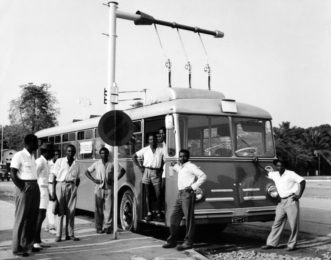
Developed by the Swiss company Oerlikon in the fifties, gyrobuses were used for approximately 7 years at Yvernon and Grandson in Switzerland, Léopoldville in Belgian Congo, and in Gand in Belgium. The technology uses an electric engine powered by a large flywheel, weighing 1500kg (one flywheel). Once the flywheel is launched, its kinetic energy is converted into electric energy and supplied to the propulsion engine. During passengers’ ascent and descent, the flywheel is reloaded, then put back into rotation. This system could reach a speed of 50-60 km per hour for an autonomy of about 6km.
The gyrobus offered several advantages : it did not produce much pollution (except for electricity production), it was not very noisy and, unlike the trolleybus, it did not require contact with overhead power lines on the path as it was charging only at stops. However the flywheel’s relatively long charge time (3-4 minutes), in addition to the danger caused by the flywheel weighing more than a ton and working at 3,000 revolutions per minute, lead to abandoning this kind of vehicle in the late sixties. Nowadays, flywheels are increasingly developed for energy storage. In Rennes for instance, the energy produced by the subway’s braking action is stored into a flywheel, to then be transformed back into electricity.



